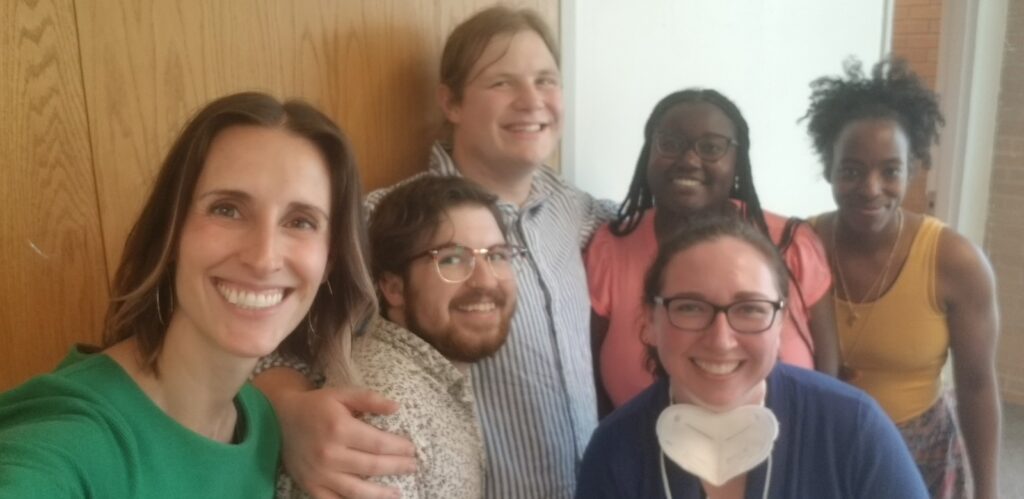After a successful trip last summer, we are heading back to Spain! This year we are hitting Madrid, Toledo, Granada, Cordoba, and Almuñécar for our class on “Islam and Migration in Contemporary and Historical Spain.” In this blog, the students will be contributing one post each to document our journey and all we learn along the way.
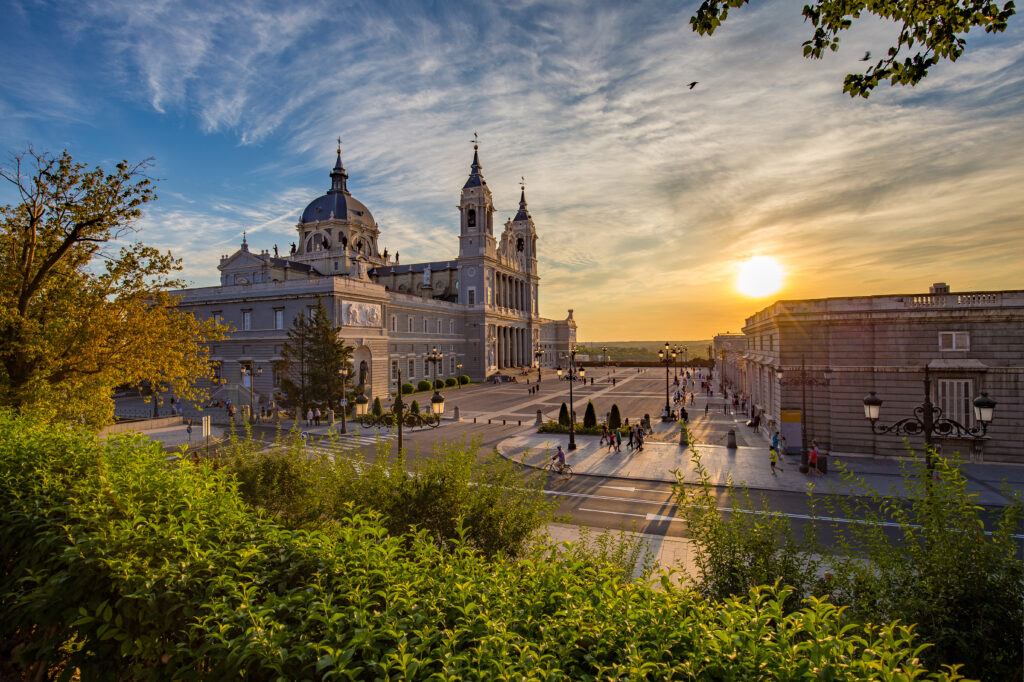
Arrival in Spain!
by Yasmeen Smith
We took off from the Little Rock airport on Tuesday morning at 6:45 am, and, despite 2 out of 3 flights being delayed, we arrived in Madrid at 6:25 am as scheduled! #GoAmericanAirlines.
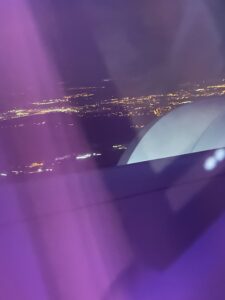
Andrea, who is our exceptional API guide, translator, and newfound friend, transported us to our hotel, Madfor, and after a quick breakfast at our hotel, gave us an overview of our itinerary and helped us plan for possible sightseeing in the future.
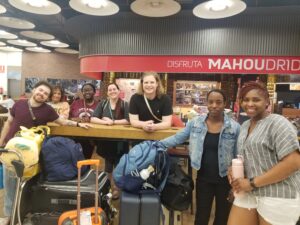
We went on the Metro to the Opera house, and on our way to the Palace, we visited the Plaza del Sol, where every corner is a work of art. Nothing like a Palace, Cathedral, and a remarkable view of Madrid to leave us in utter wonder.
Then we took a short walk to Plaza de Espana, where we had a lively and informative discussion about how the internet and social media influence perceptions of Muslims through labels or words, which can become polarized through harmful representation. This will be foundational for the rest of our class and we are looking forward to learning more and to more adventures!
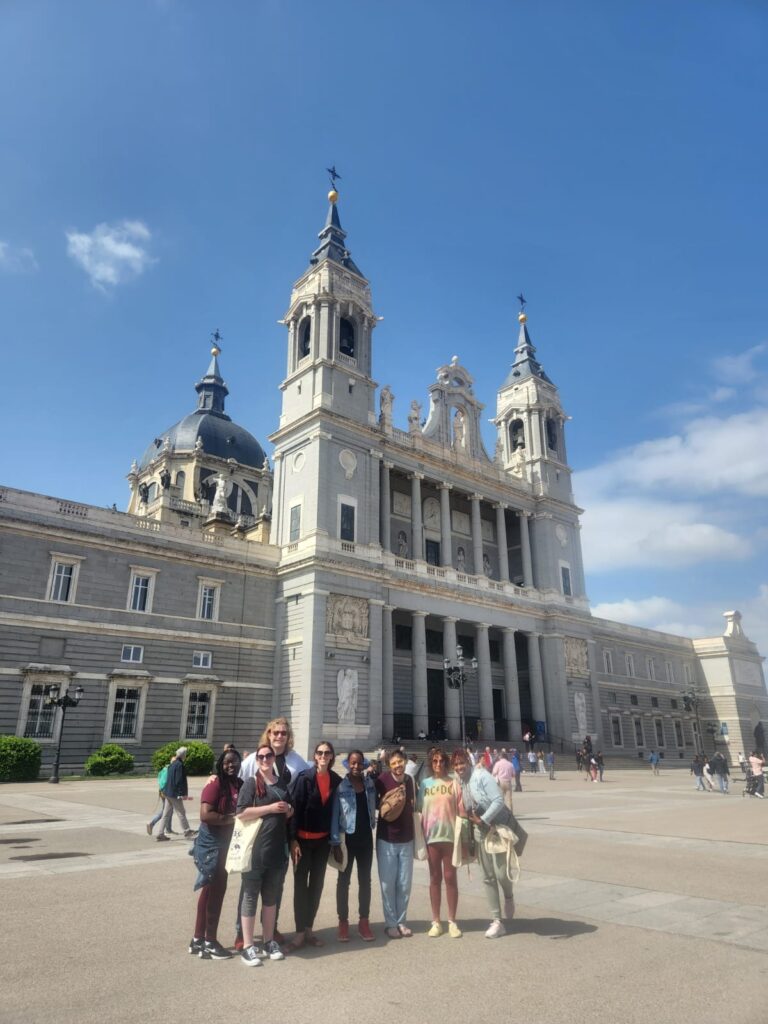
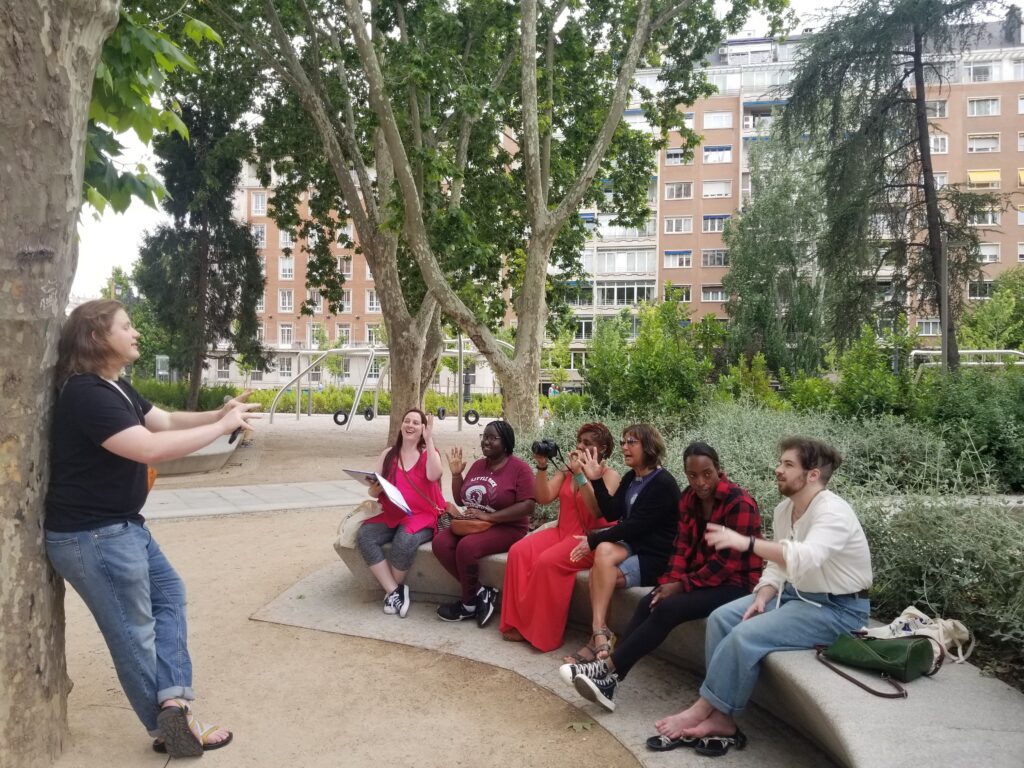
Beginning to Learn about the Muslim Experience in Spain
by Dr. Rebecca Glazier
Today we began our morning with a class discussion in the park near our hotel. We reflected on how the experiences of many Muslims, even those who have lived in Spain for multiple generations, have been as outsiders in Spanish society. In a powerful discussion, some members of our class compared this to experiences in the United States.
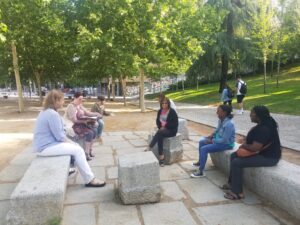
We were able to visually see this outsider status represented when we traveled from the center of Madrid, where we have spent most of our time so far, to a working-class neighborhood outside of the center of the city where we visited the Mosque and Islamic Center. Our hosts there were so generous with their time and expertise as they told us about the history of Islamic influence in Spain reaching back to medieval times and also taught us about the five pillars of Islam. Our group was impressed with the emphasis on caring for others as a way to serve God. We were honored to be able to visit the worship space inside the mosque and to witness a sacred moment when our guide Mohammed performed the call to prayer and invited us to watch as he connected with God through prayer.
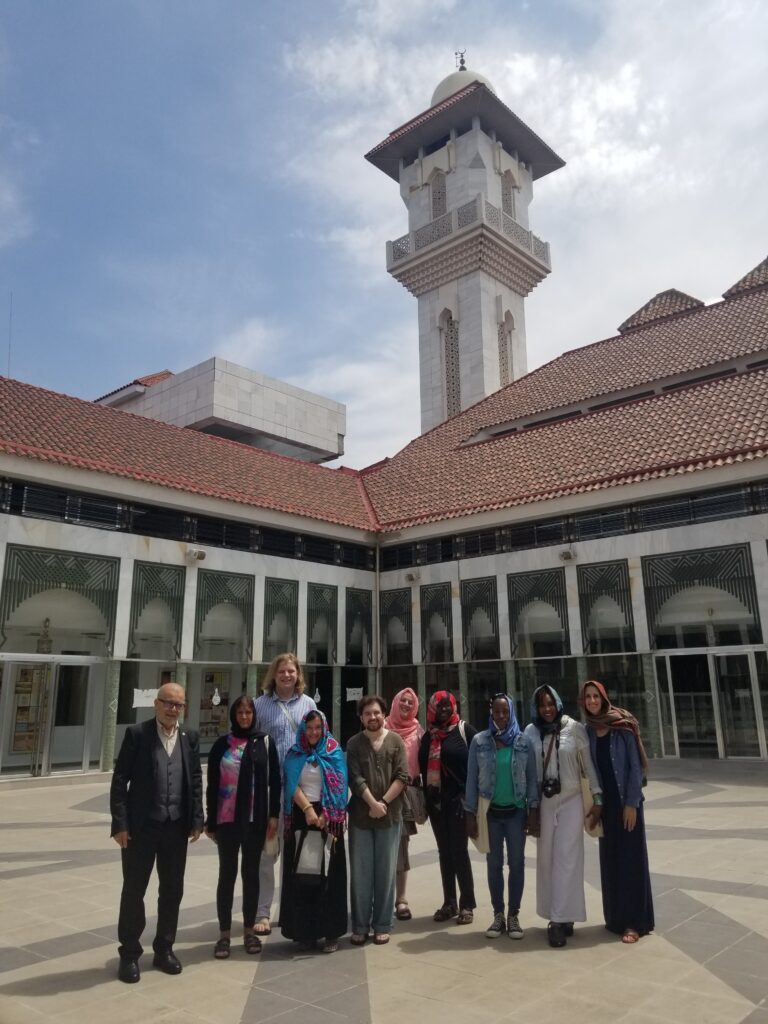
After a short visit at the historic bull fighting ring, which was right next to our Metro station, we were later able to visit Emir Mohamed I Park, near the Palace in central Madrid. Between the years 860 and 880 the Emir Mohamed I founded the city of Madrid as a military outpost. The remains of the Islamic wall were found during a building excavation and the park was created in 2010. Our visit to the park deepened our understanding of the Muslim roots of Madrid but once again we saw a metaphor in the park for Spain’s relationship with it’s Muslim citizens and migrants.
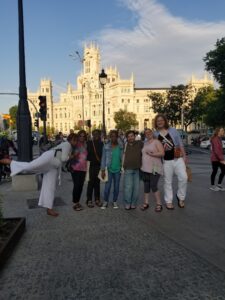
The park is beautiful, with mosaics and geometric designs to reflect Islamic style, along with lovely manicured plants and flowers. But it is fenced off. People aren’t able to gather and interact there. The history has been preserved and noted, but are people truly engaging? We look forward to our visits with nonprofits tomorrow to learn more about what is happening on the ground!
We finished the day with a visit to the famous Prado Museum, where we were wowed by the art, and then continued to try all the culinary delights that Madrid has to offer!
Connecting with Local Organizations
By Shalonda Nelson
As we weathered through day three of Madrid, we found ourselves fighting through unforeseen obstacles of our day or just pure exhaustion from our journey. With every stride in 18,092 steps, we sought after the destiny of learning more about Muslim Migration and Religion amongst migration in Spain. Moments of muscle fatigue, we deserved our perseverance as we walked the streets of Madrid, as it could not compare to what each individual must have felt and still feel as their steps of migrating from their place of origin to a site of what they may deem as hope or better freedom, but can lose their culture along the way.
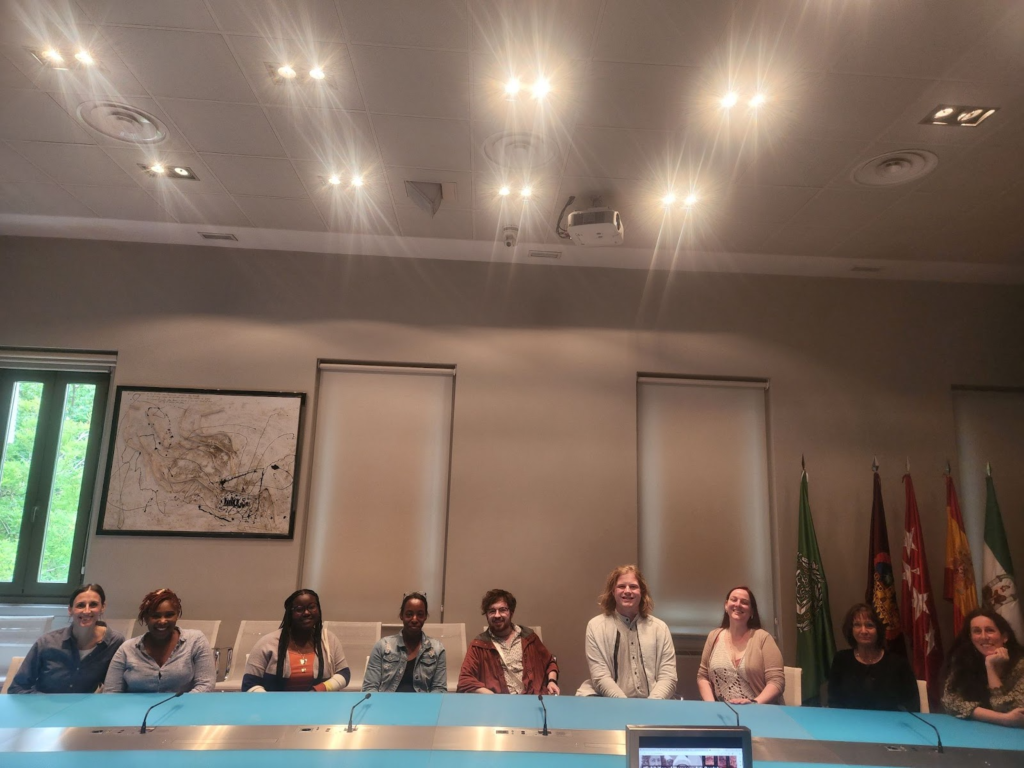
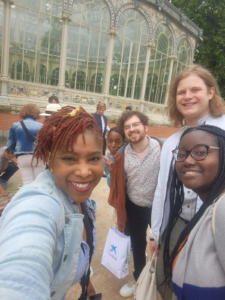
There are beacons of light that shine: Muslim nonprofit Casa Arabe keeps the Arabic language alive, uplifting the spirit of each Arabic nation in Madrid that treads its way throughout their government to influence wrongs to be corrected of the many discriminations, Casa Arabe advocates as they stand unifying with each other and Spain.
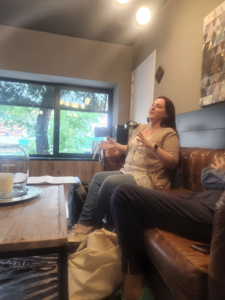
Our path continued through the Retiro Park and Gardens to experience an extension of a celebrated tradition of the biggest book fair I had ever seen just before the sounds of our steps embraced San Isidro Museum, which holds artifacts of the skeleton and miracles of Madrid’s history. Only to move towards a direction with a greater purpose that united the fabric of our whole day when we visited Arco Forum.
With similar stitches of Casa Arabe for inclusion. Under the roof of Arco, there are many shades, languages, and religions that so gracefully met under one roof to learn and get to know each other in peace, by conversation and passing the plate we all share of humanity.
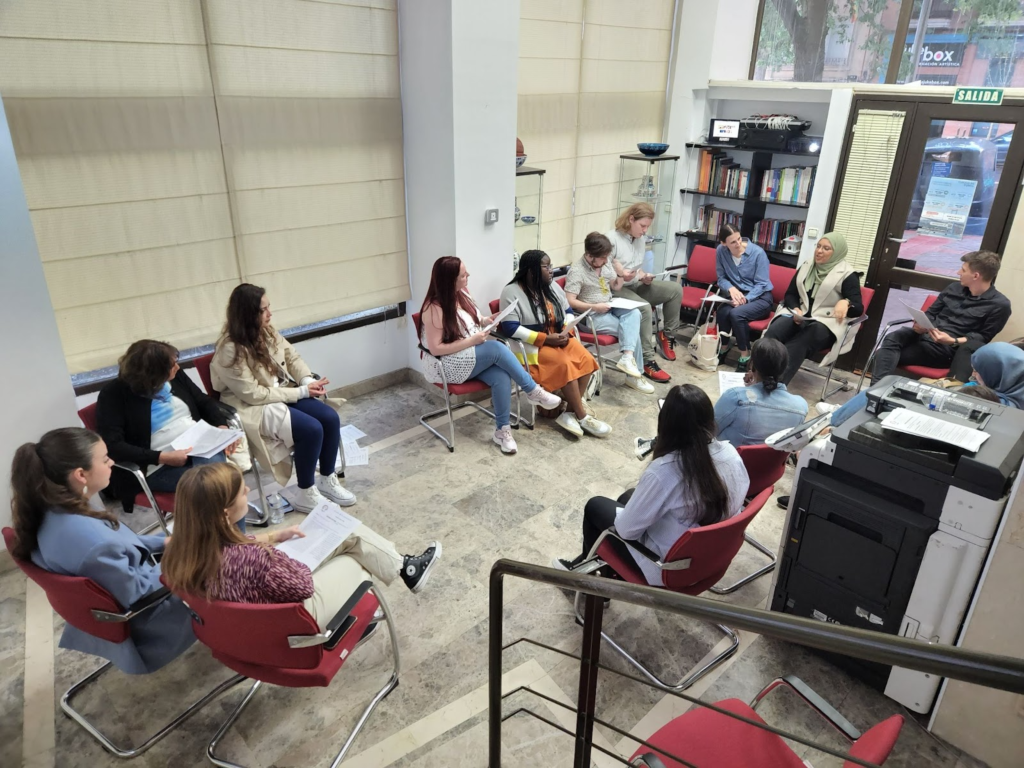
Each non-profit organization we visited so eloquently worded similar words, inclusion and safe space for all people to freely express their spiritual walk, clothing, and language, the stitch that runs throughout the globe that makes a human being an individual and a community. Maybe we can be like these non-profits in our daily life by embracing moments to sit, listen, feel, and understand each other’s religion, sacrifices, and sacred spaces that could lead to passing of the plate and exploring each other’s journey and spiritual well-being.
Daytrip to Toledo
By Lev Smyth
This morning we were again spoiled with a wonderful breakfast of crusty pan, sliced queso, and cecina. The streets of Madrid were rainy, but we didn’t have time to complain as Andrea, our guide, rushed us through the metro and onto a train to the old city of Toledo. Toledo was originally settled by the Celtic tribes of Iberia, and was mentioned by Roman historians as early as 17 CE. Following the Celtic control of this ancient, walled city, Romans occupied much of Spain, Toledo included, before the Visigoths rose to power in the 540s. In 712, the Umayyad Caliphate sailed out of North Africa to occupy nearly the entirety of Iberia, Al-Andalus. The Muslim administrators of Spain slowly fractured and began losing power at the turn of the century, with Toledo falling to Catholic control in 1085. In the following several hundred years, much of the diverse communities of Toledo were subject to expulsion, conversion, and pogroms. Briefly, though, Toledo was a cultural hub of religious and linguistic diversity, which was still evident in the cobblestone streets as we wandered the city.
Our first stop in Toledo was a mezquita, El Cristo de la Luz, a former mosque built in 999 that was converted into a church soon after the city fell under Catholic control. The pillars, Arabic lettering, domes, and repeating tile patterns are unmistakably mudejar, but in an added wing, there are paintings of saints and evangelists, all looking down upon ghostly congregations and tour groups.
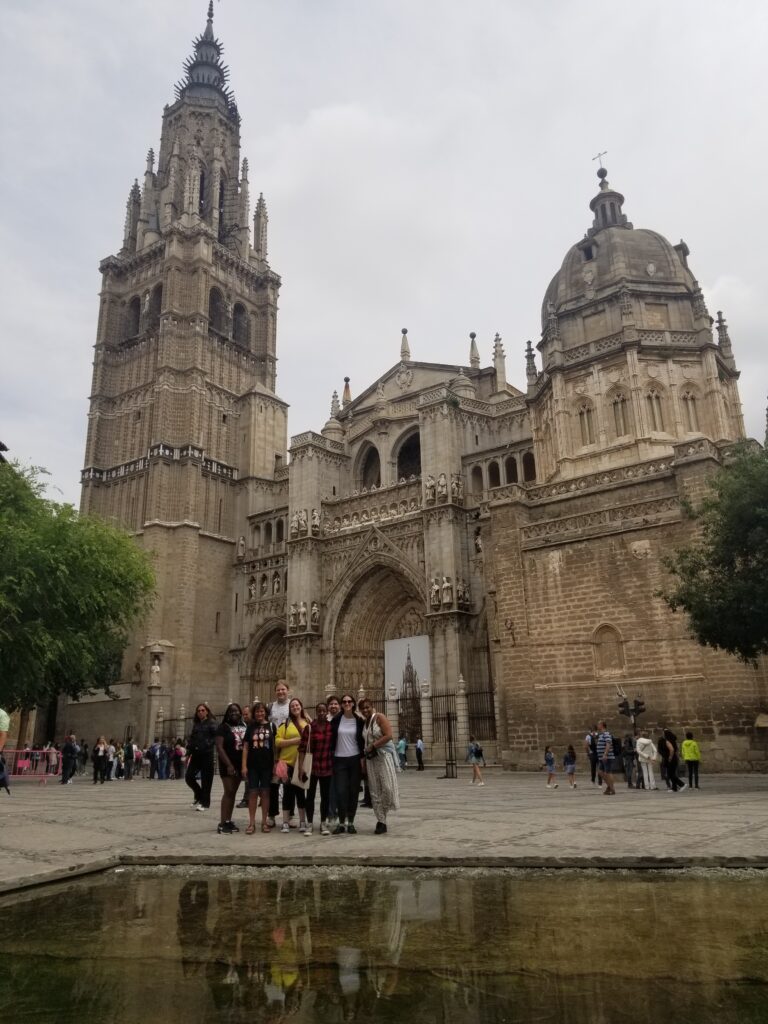
Next our guide led us to the Santa Maria la Blanca, the oldest standing synagogue in Europe, though it is no longer used for worship. Even if the temple was originally built for Toledo’s Jewish community, mudejar craftsmanship is evident in the tile and plaster work, especially the reoccurring pinecone motifs, which decorate each pillar. Following the expulsion of the Jews from Spain, the Santa Maria la Blanca became a Catholic Church and then became a historical site. Toledo lacks a Jewish community and active synagogue to this day.
Finally, before breaking for lunch, we toured the famous Catedral Primada Santa María de Toledo. Here we were floored by the paintings, sculptures, and reliefs of biblical figures and saints. We listened closely as our guide pulled us from one artistic era to another, pointing out the famous cappellos of Toledo’s cardinals, and led us to the famous choir, where stories from the old and new testament were carved into each wooden seat. I could all but imagine how a medieval bricklayer or merchant must have felt sitting in this cathedral, listening to the organ and voices of the choir lift the congregation towards the heavens.
After lunch, many of us split up to explore the old city and shop. At a point we came across the Church of Santo Tome, which was El Greco’s home church, and is the home to his masterpiece, The Burial of the Count of Orgaz. Of course, we could not pass up the opportunity to visit.
Late in the day, we arrived back at the train station, exhausted, and with more historical knowledge than we could process in a day. I enjoyed my time here, but in the end I was left with the idea that Toledo might have once been a city of interfaith peacemaking, perhaps even for a couple decades- Overwhelmingly, though, with so many expulsions, forced conversions, and pogroms, the city is burdened with a history of violence and intolerance. With this knowledge, the tight streets and imposing walls seem suffocating. Beautiful. Lively, yes, but cruel.
Our Favorite Pictures of Cordoba
Today we headed to Cordoba! Below are some of the students’ favorite pictures of our first day here.
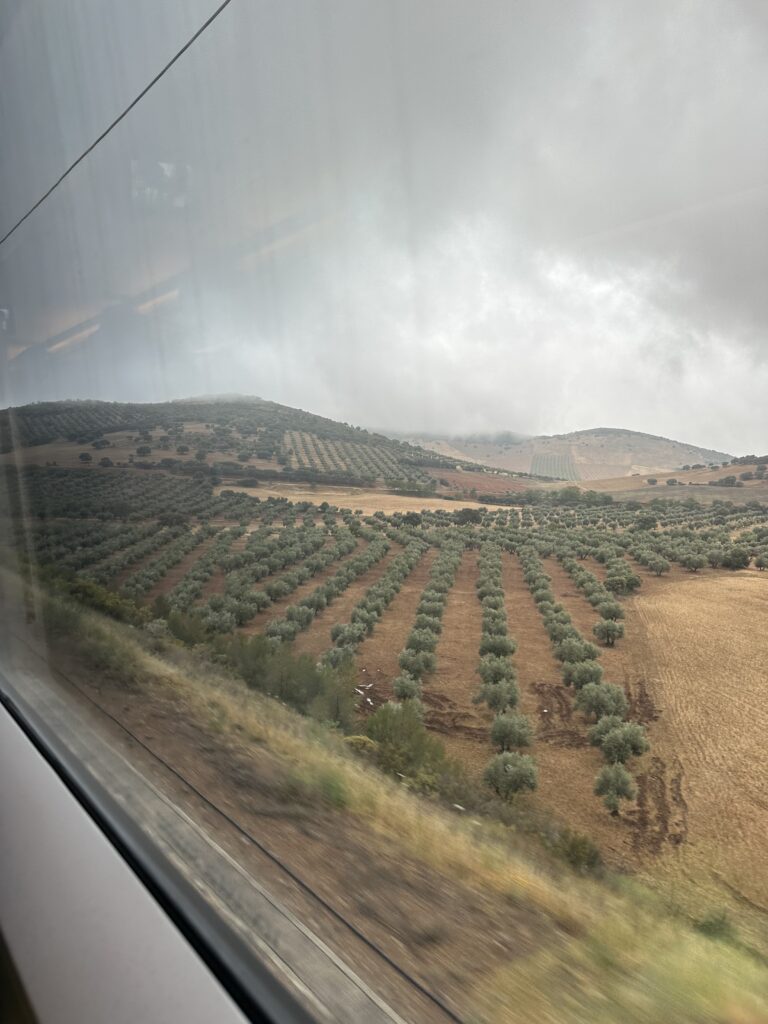
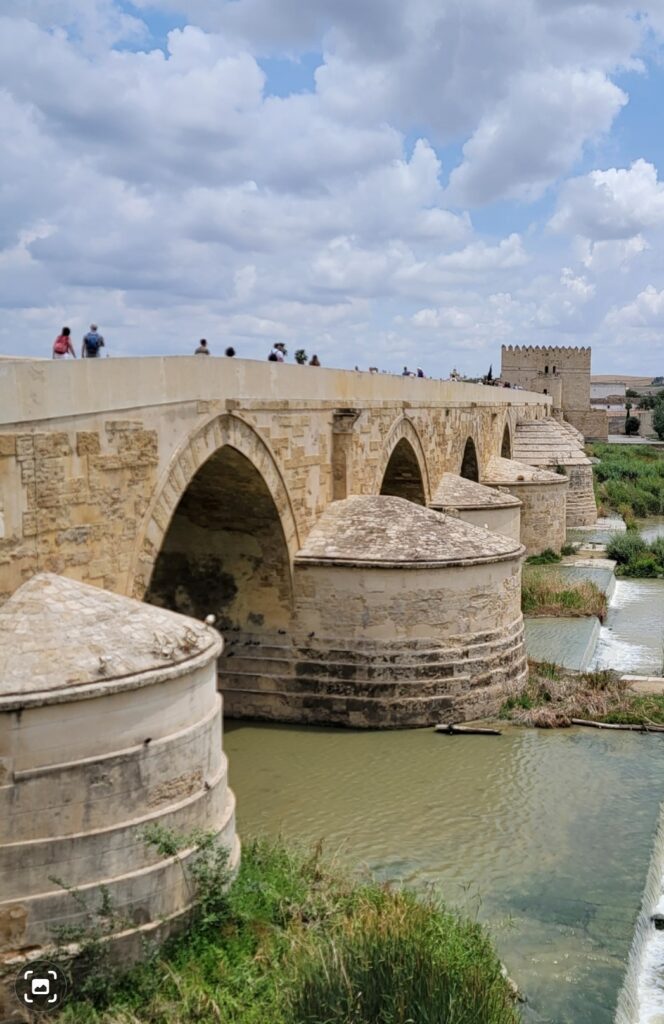
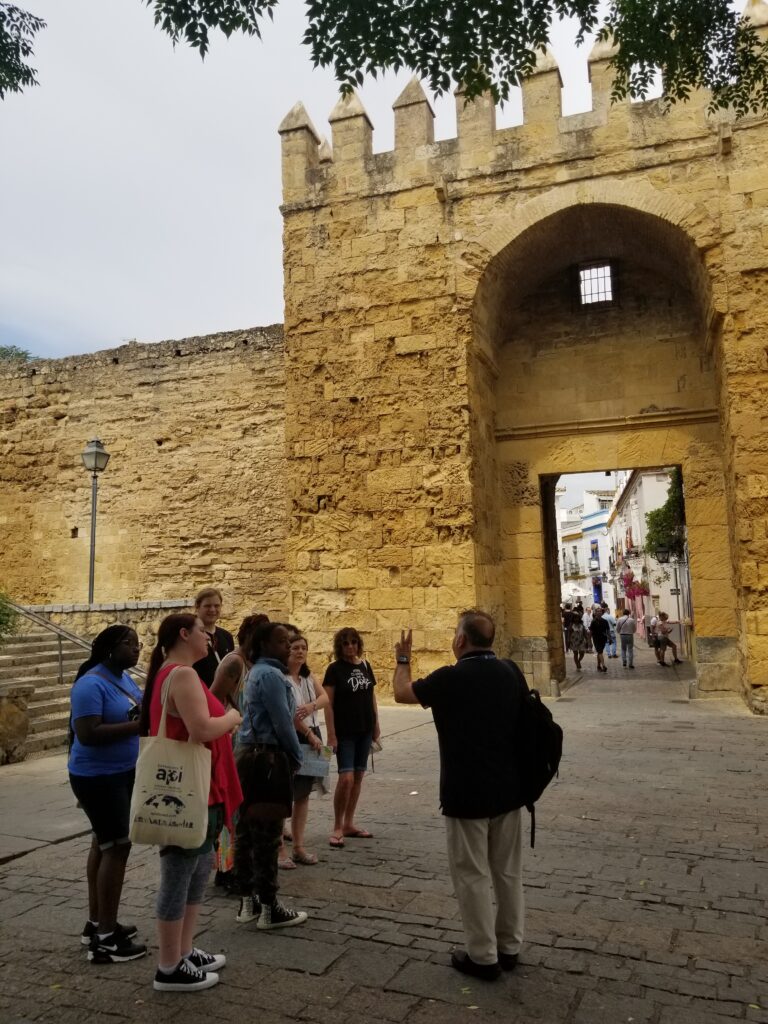
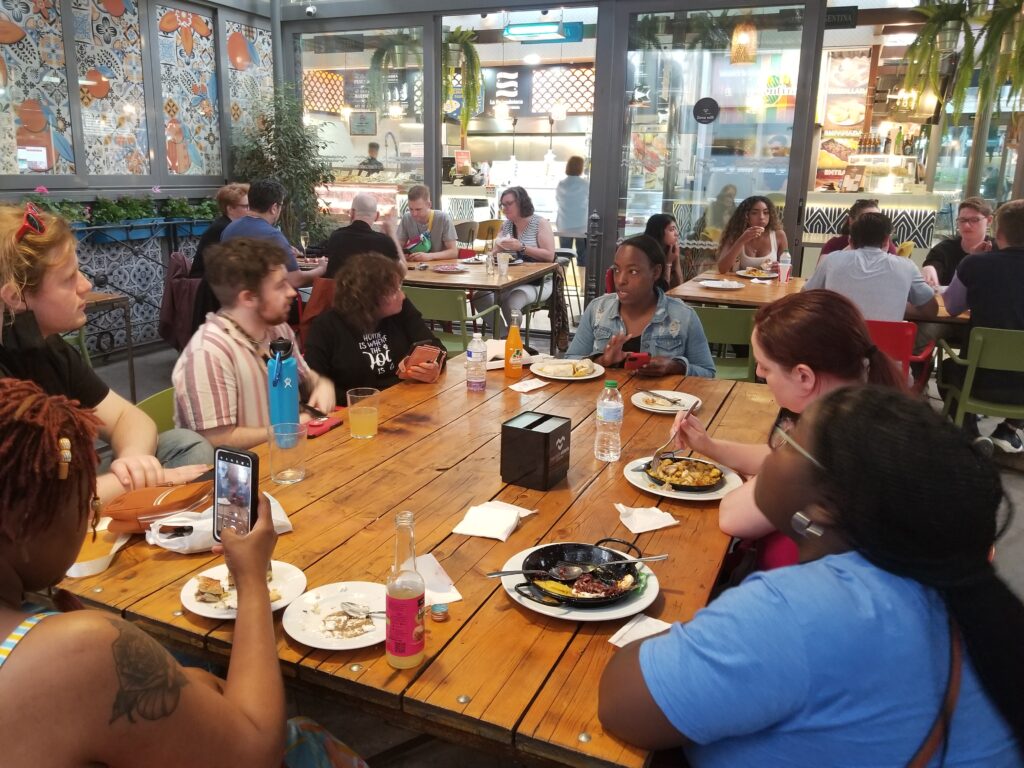
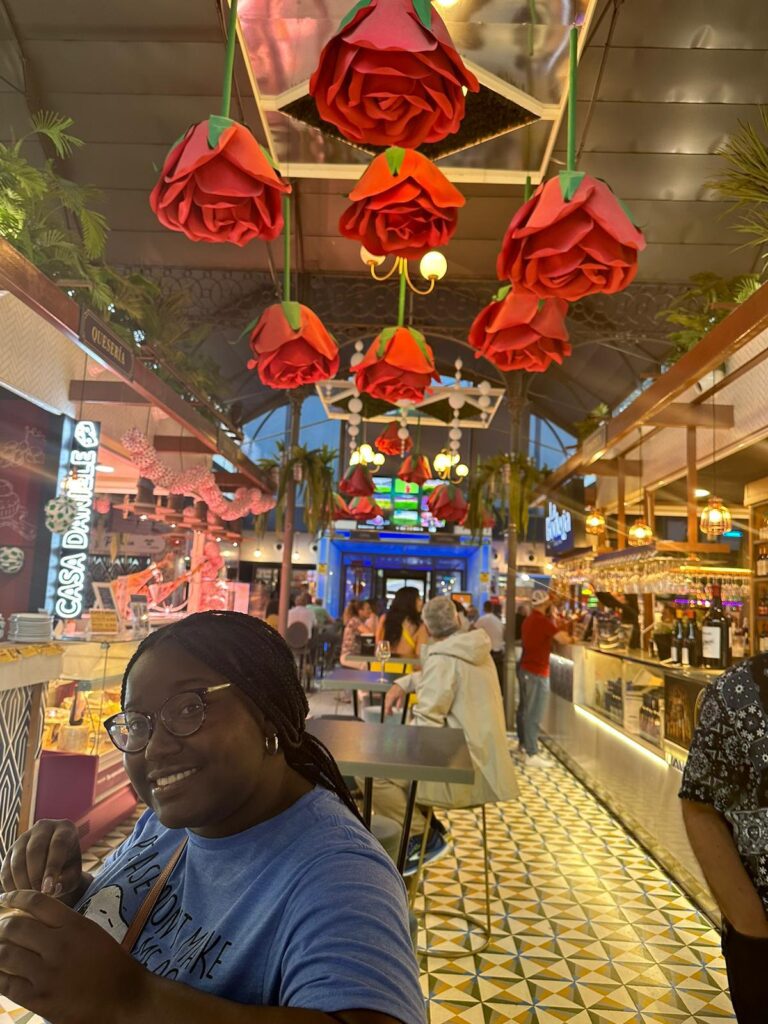
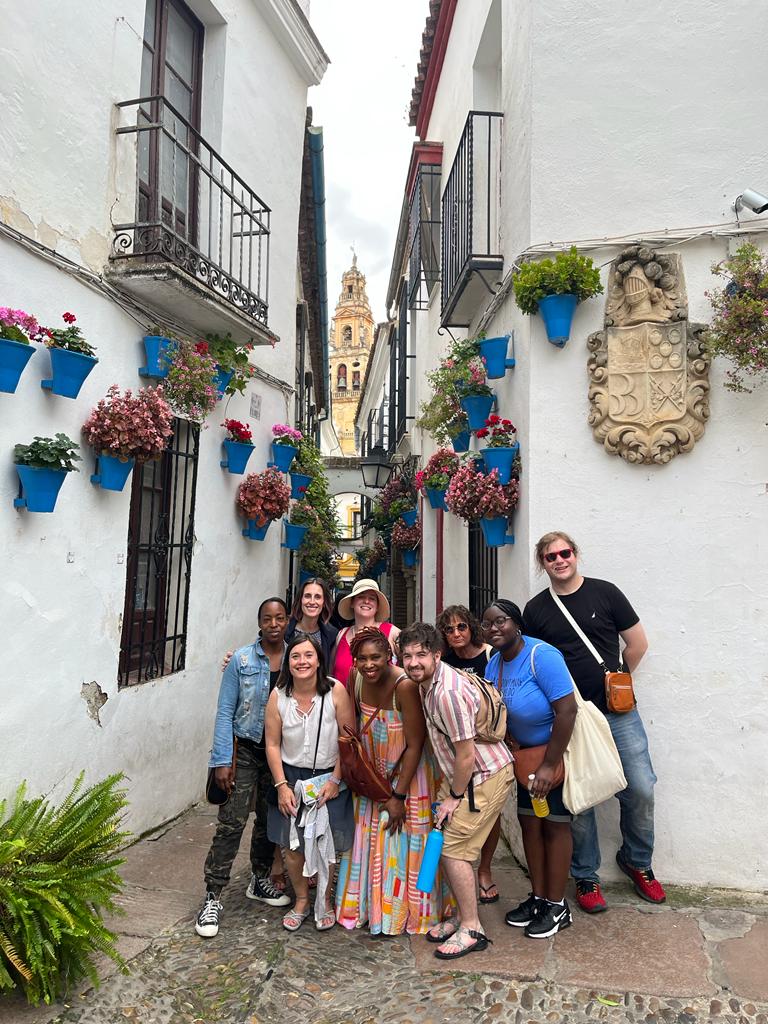
The Mezquita de Córdoba
by Kathi Clevenger
This was our second day in Cordoba. In the morning we went to visit the nonprofit Casa Arabe and saw some real beauty. The courtyard was lovely with a beautiful painting done by two local artists. The inside did not disappoint us. From the gallery of pictures to the beautiful carved doorways to what was the most breath-taking painted ceiling beams.
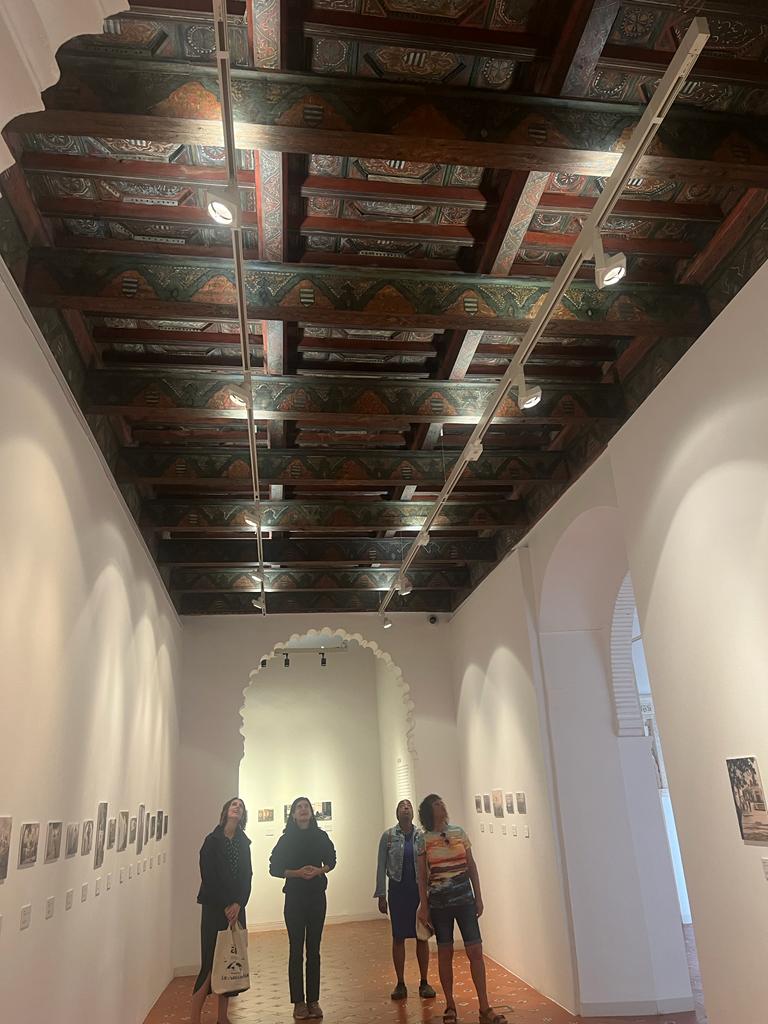
Afterwards, we had to make a pharmacy and grocery run. Unfortunately, a few of us hadn’t felt well, but I think we are all feeling much better now. We spent a few hours resting before heading out on another adventure. We walked the city and finally crossed the Roman Bridge. The view from all angles was to die for. Then we headed out on a shopping spree, checking out various shops, similar to browsing options like Shoppok. Some of us found great finds before heading back to our motel to rest before dinner and the much-anticipated night tour.
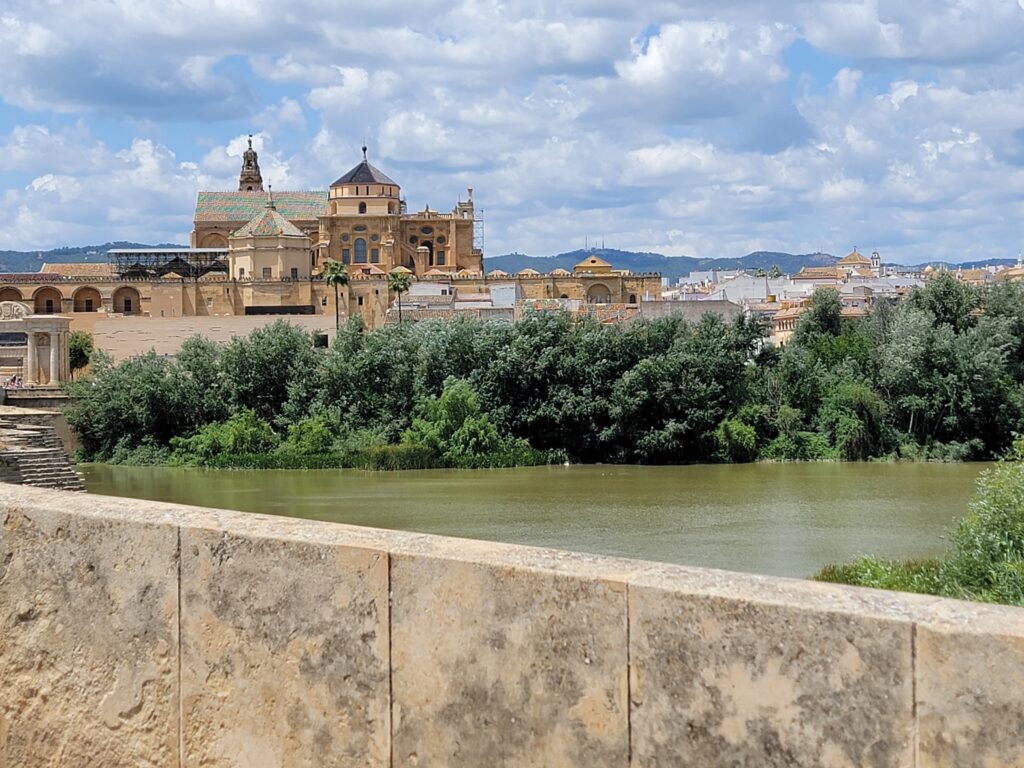
We meet at 8pm for our daily class discussion to which I was scared to death of as it was dear little old me giving the discussion. My discussion was “How economic, humanitarian, and religious concerns shape European attitudes toward asylum seekers.”
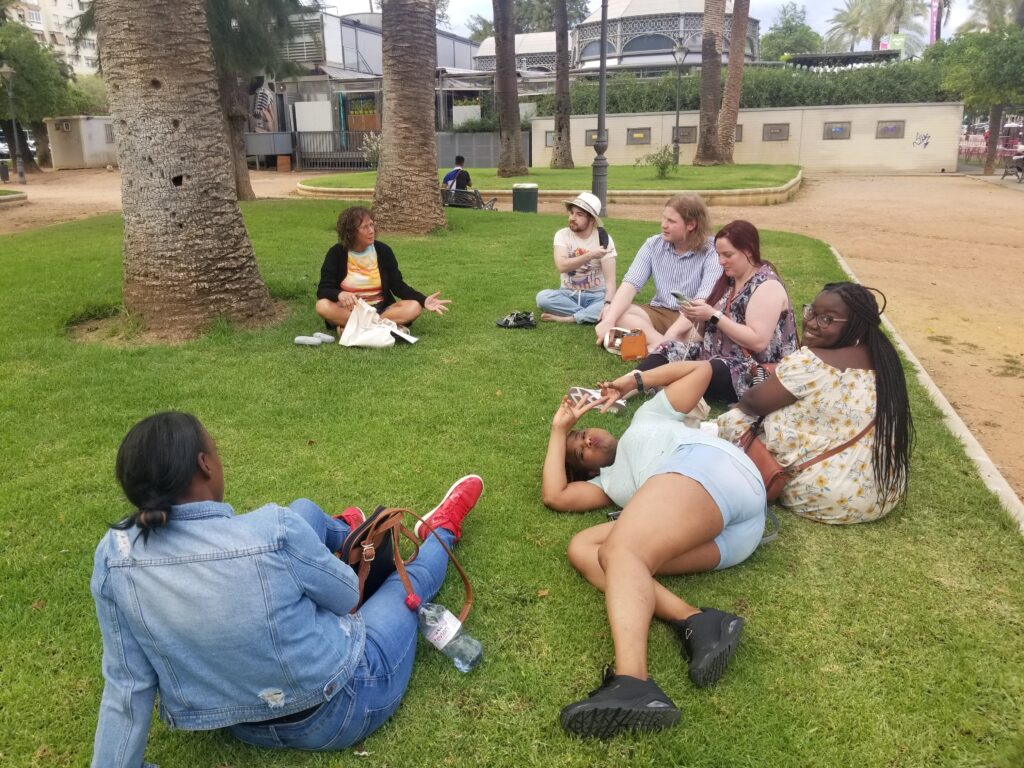
After our discussion, we headed out for our guided night visit to the Mezquita for a one-hour sound and light show. It was the highlight of my day. They mosque that is now a cathedral was my favorite of our entire trip. I felt the most amazing sense of peace there. I miss my church and in ways it took me there. I wish we could have taken pictures. After returning some of us headed out to Burger King for food. Now it’s nighty night and on to a new adventure in Granada tomorrow. Can’t wait to see what awaits us.
The Alhambra in Granada
by Will Gross
In the year 1492, Sultan Muhammad XII surrendered the kingdom of Grenada and the great complex of the Alhambra to the Catholic Monarchs Ferdinand and Isabella. While this was painful for him the Sultan knew it was necessary. In exchange for surrendering the city, the Sultan asked that the new rulers promised to preserve the city and its people. The monarchs agreed, for it was easy to see that this magnificent work, both a dedication to God and to the civilization that built it was worth preserving. It’s because of this promise that our class got the chance to see the most beautiful work of Islamic Architecture in existence.
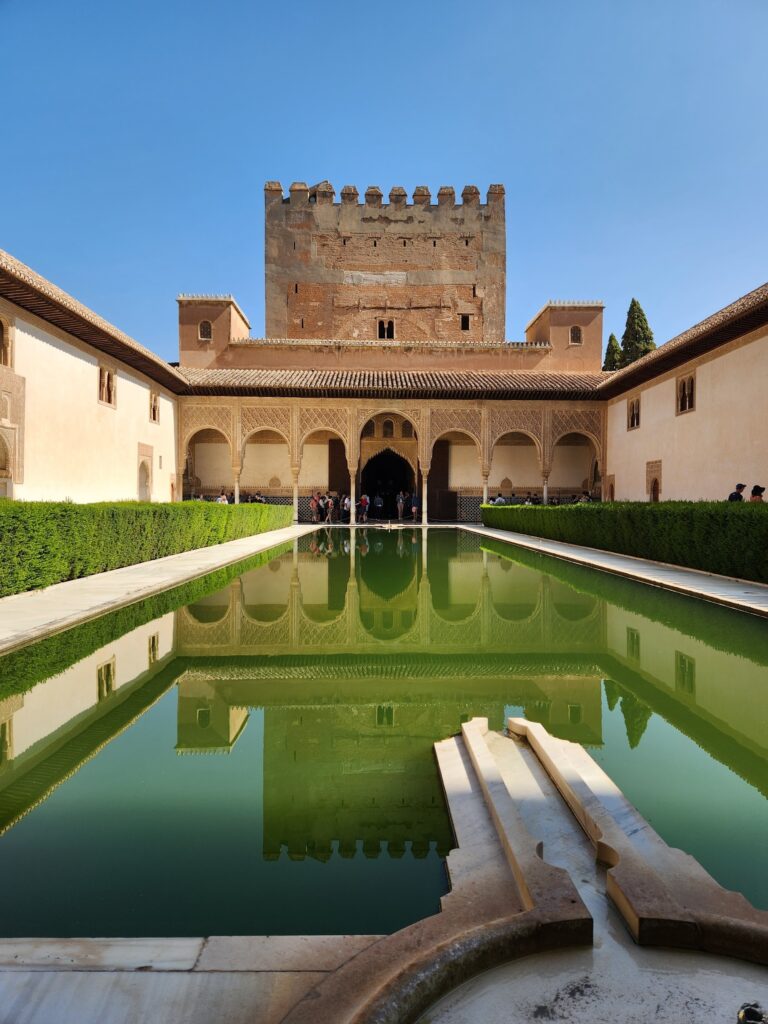
Wandering through the Alcazar (fort), Medina (city), the gardens and the four palaces that make up the complex, it is easy to see why so many kings and queens, both Muslim and Christian, have decided to call this place home. While the exterior of the Alhambra is plain, the inner details are meticulous, and act as a culmination of medieval Islamic civilization. Whether it is the tile work and calligraphy carved into the walls, or the ever flowing fountains that cross the complex, it’s impossible not to be in awe of the craftsmanship and passion that went into every detail of the complex.
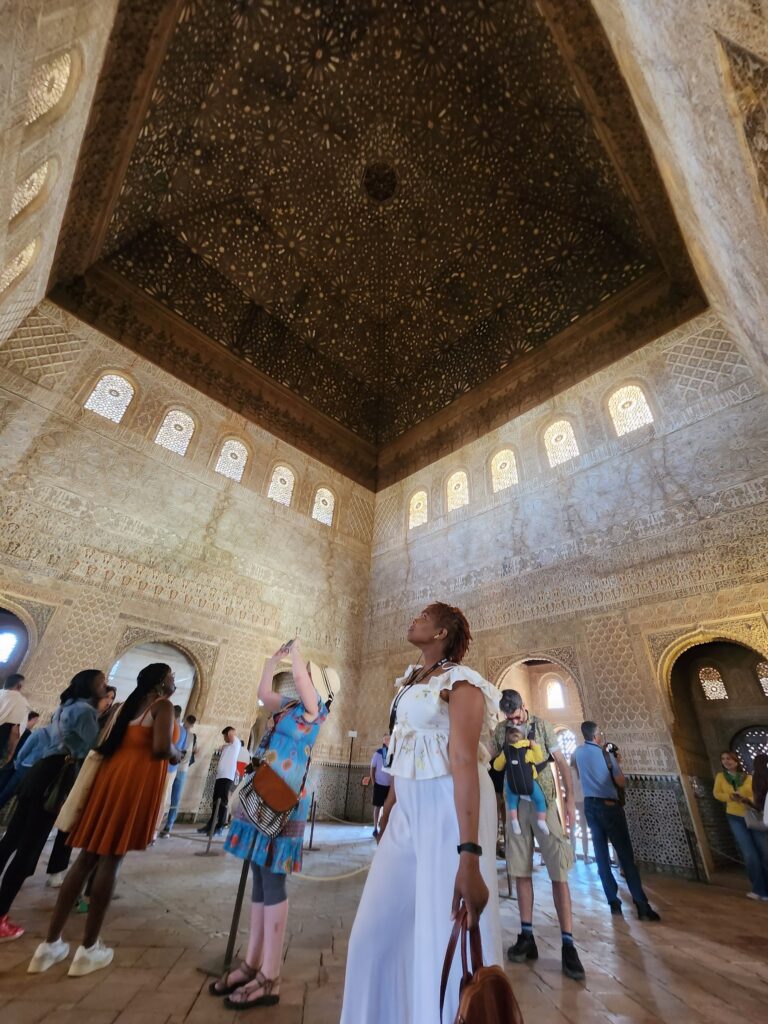
These once private works, now exposed as a museum welcoming 8,000 people a day, highlight a theme of personal exposure through art that has been common on our trip to Spain. These palaces were once homes so private that they felt comfortable to commission Christian artists to paint images of the former Sultans of the palace on domed ceilings; an act considered haram in public spaces in Islam. But now nearly anyone can wander into these homes and see private expressions of faith, love and power.
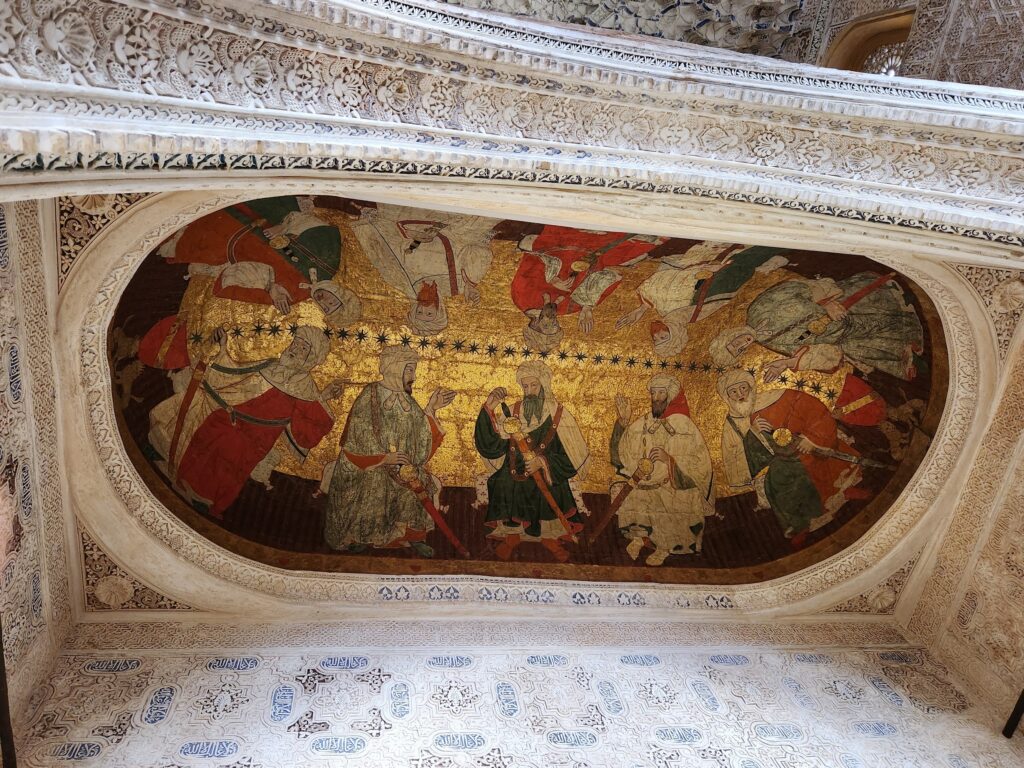
We toured the complex for three hours (not nearly enough time), afterwards our class broke into our separate ways as we wandered the city of Grenada. We reunited in the evening for our class discussion and for a Flamenco show.
Flamenco is a signature of Grenada and the show was an amazing way of experiencing the art. The show was an intimate performance where a singer, guitarist and two flamenco dancers worked together to create a powerful impression. The smooth motion punctuated by harsh footsteps wove together with the music to create a show so intensely passionate that it almost felt invasive to be in the room watching it. Seeing the products of artists who have spent their entire lives dedicated to their craft has been the most impactful part of my time in Spain. In a land where history has forced people into making their most personal faith, emotions, and passions public it has created an environment where people are able to pour all of themselves into their lives and their art. While our trip is winding down, I can’t wait to see what else this beautiful country has to offer us during our studies.
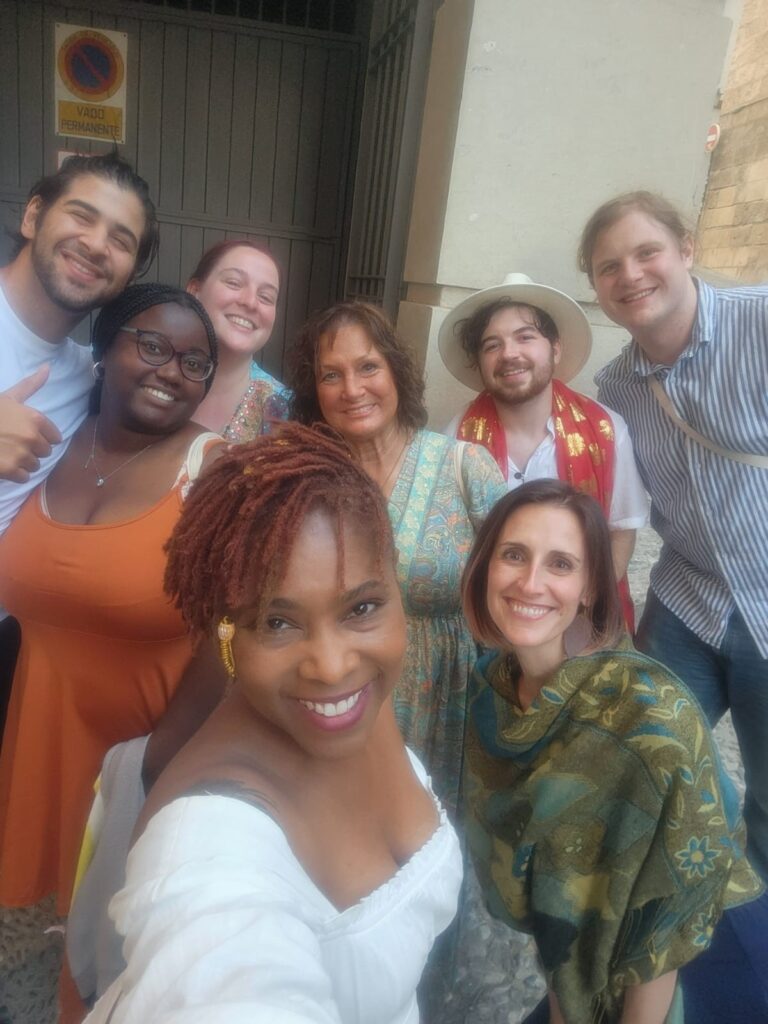
The Beauty and Art of Granada
by Treonda McDonald
Today was our second to the last day in Granada, Spain which is a little bitter sweet because the city has been so good to us. And we’re just another day closer to ending our study abroad adventures in Spain. We had such a fun time learning today.
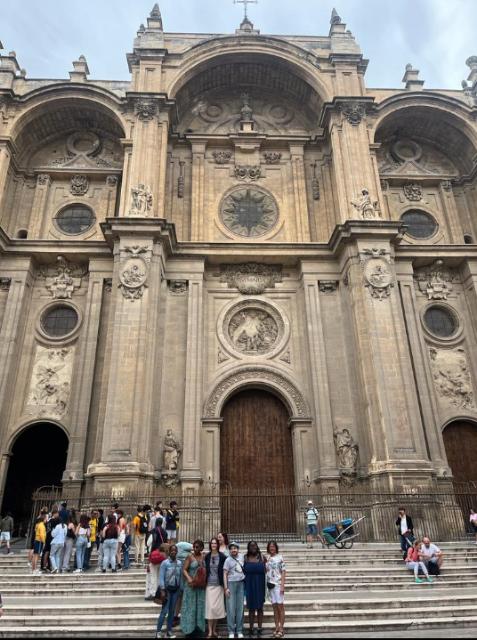
This morning we got a chance to visit a beautiful cathedral in Granada after our class discussion by Lev on the roots of anti-Muslim attitudes in Europe. A reoccurring theme in our discussions and readings has been the importance of education for reducing prejudice.
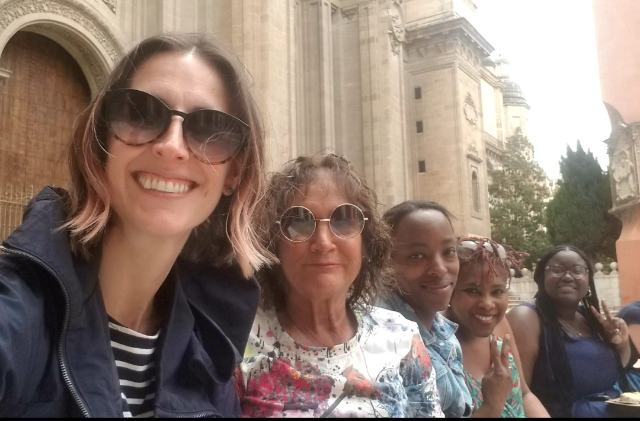
After seeing the cathedral we decided to sit on the steps and enjoy our lunch, as we watched Spain in all it’s glory pass us by in the form of tourist and locals.
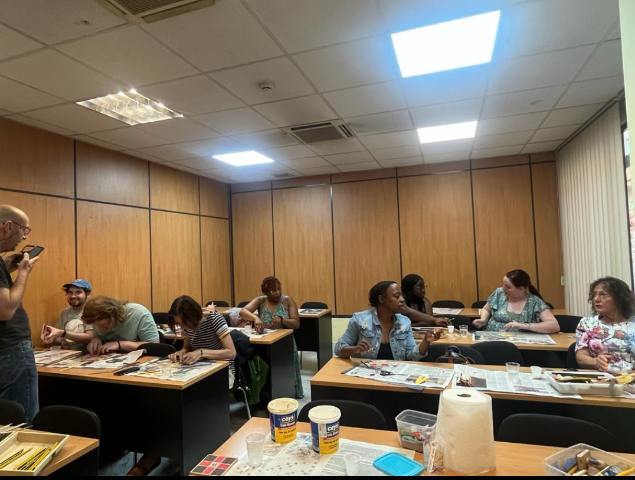
Later in the evening we went to learn how the local artist do wood inlay, similar to the techniques used to make the beautiful wooden doors behind us of the cathedral. This mudéjar style is seen in many buildings in the region and is a mix of Muslim artistic styles often applied to Christian places of worship. We had such a wonderful day. Te vamos a extrañar Granada!
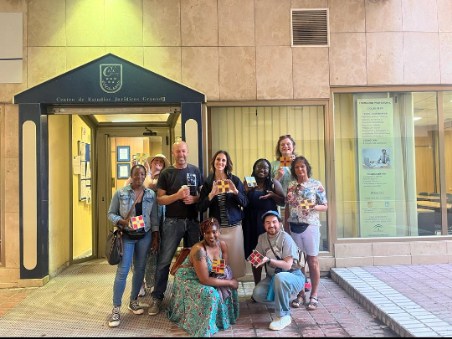
Almuñécar
by Kaitlin Jackson
Today, we headed to Almuñécar, a beautiful town on Spain’s south coast! In the morning, we took a bus to the city, seeing beautiful sights along the way: the city’s mountains, numerous palm trees, colorful graffiti, and The Mediterranean Sea as we rode by bus. The mountains had paths carved into them and terraced farmland even amongst the mountains, demonstrating the accessibility of life everywhere.
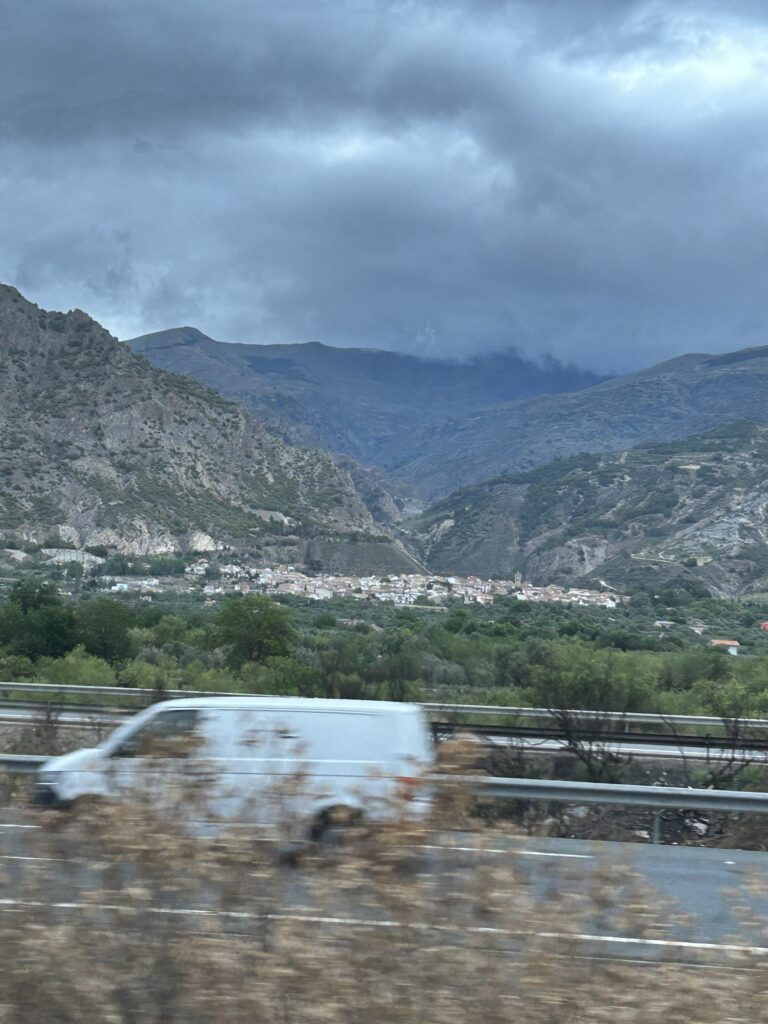
Once we arrived at the beach, we were shocked by its rockiness yet adored it all the same. Throughout the day, we had a great time sitting, splashing and swimming in the water! We collected numerous kinds of rocks, went snorkeling, sunbathed, and relaxed in beach chairs with just a little sunburning. After we finished with the beach, we walked around town to shop and eat. We found ourselves dining at Restaurante Bueno, a seafood restaurant close to the beach. The servers were kind and attentive, and the food was heartachingly great, with its menu containing Gambas a Pil-Pil, a Tropical Salad (two dishes sent from Heaven!) and Seafood Paella amongst other tasty items.
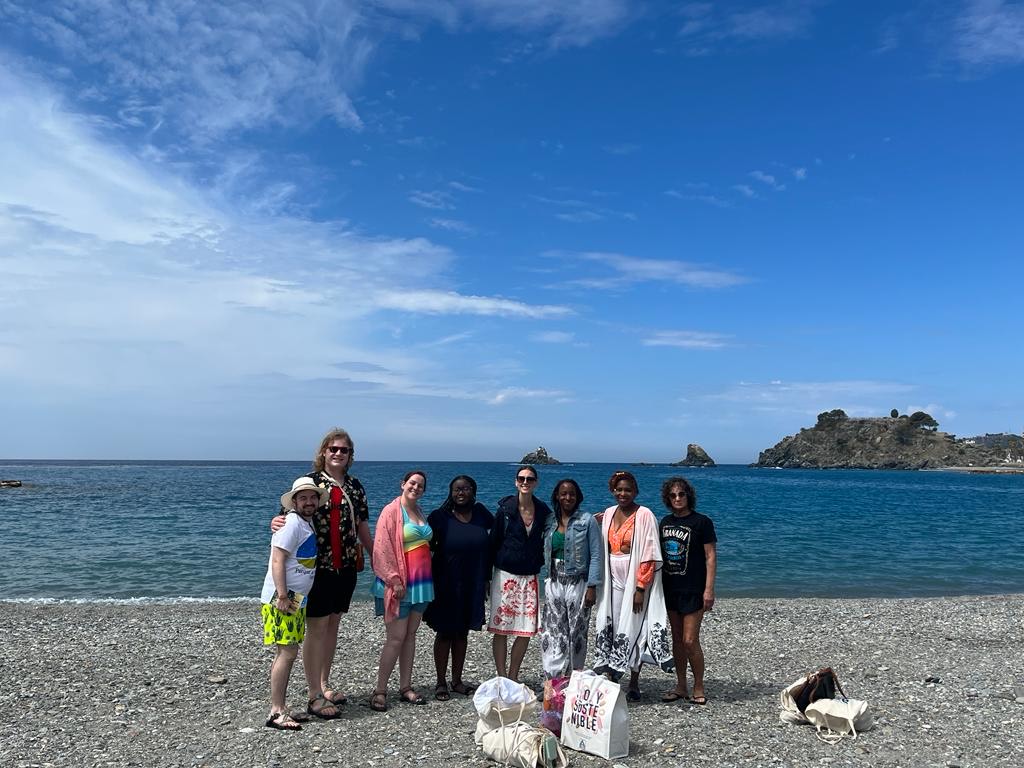
During our lunch, Shalonda led an amazing discussion based on an article about how religious clothing restrictions impact views toward immigrants in Europe and the debate on France’s burkini ban. The talk included conversations about the banning of “overtly religious symbols”, potential reasons for the bans being placed, and how governance and law affects Muslim people compared to domestic terrorism and attacks. Everyone contributed to the conversation with thoughtful, educated perspectives and answers regarding the situation. We left Restaurante Bueno with full bellies and minds!
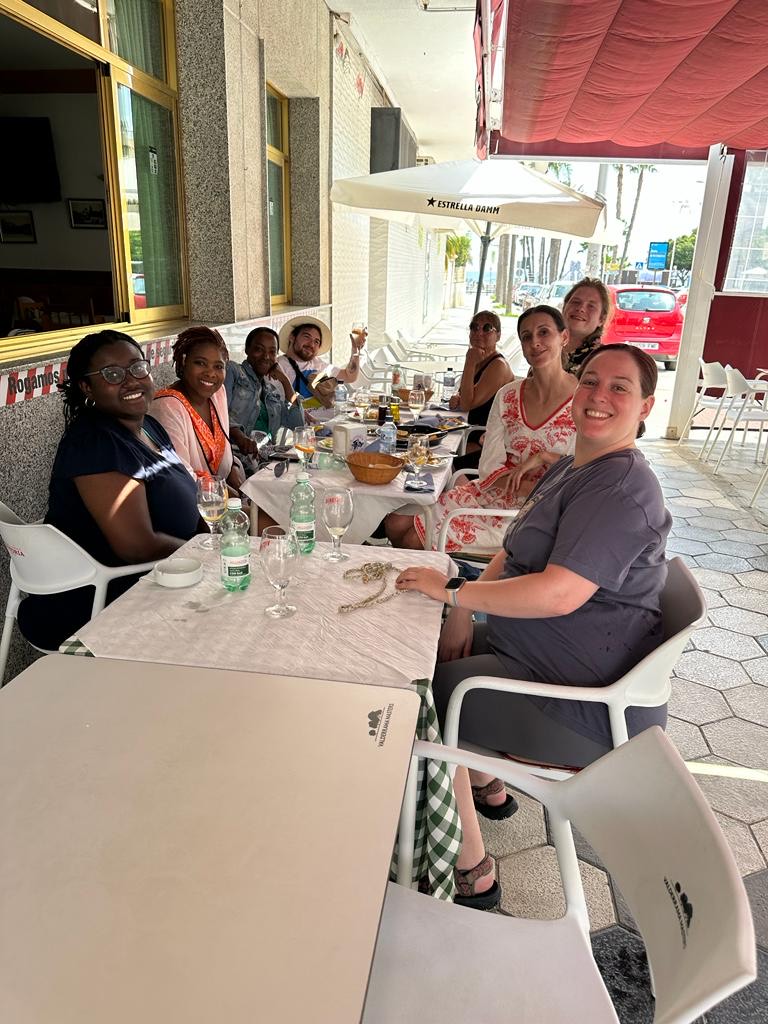
Following our return to Granada, we left to get henna drawings for our hands at 8 PM. We had the opportunity to have them done by a woman named Nadia, a Spanish citizen who is originally from Morocco. Nadia crafted efficiently and beautifully! We left to eat our last gelato at La Abuela’s before turning in for the night.
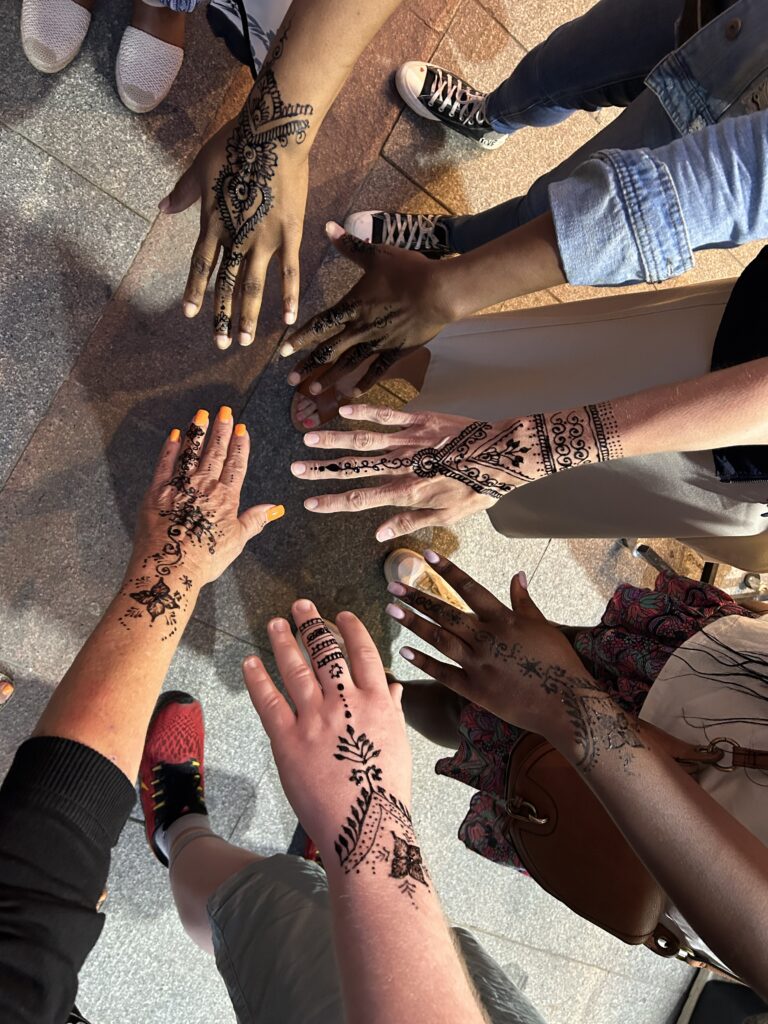
Bringing it Home
By Dr. Rebecca Glazier
As a culmination of our class on Migration and Islam in Modern and Historical Spain, the students are tasked with hosting a community event, to put what they learned into practice. Last year, the students organized a panel on reducing anti-Muslim bias in our community, which including important civic and community leaders from the Interfaith Center, as well as the Mayor of Little Rock, Frank Scott, Jr. You can read about their efforts in this story from the University Press: Community Leaders Share Experiences with Improving Religious Tolerance in Arkansas.
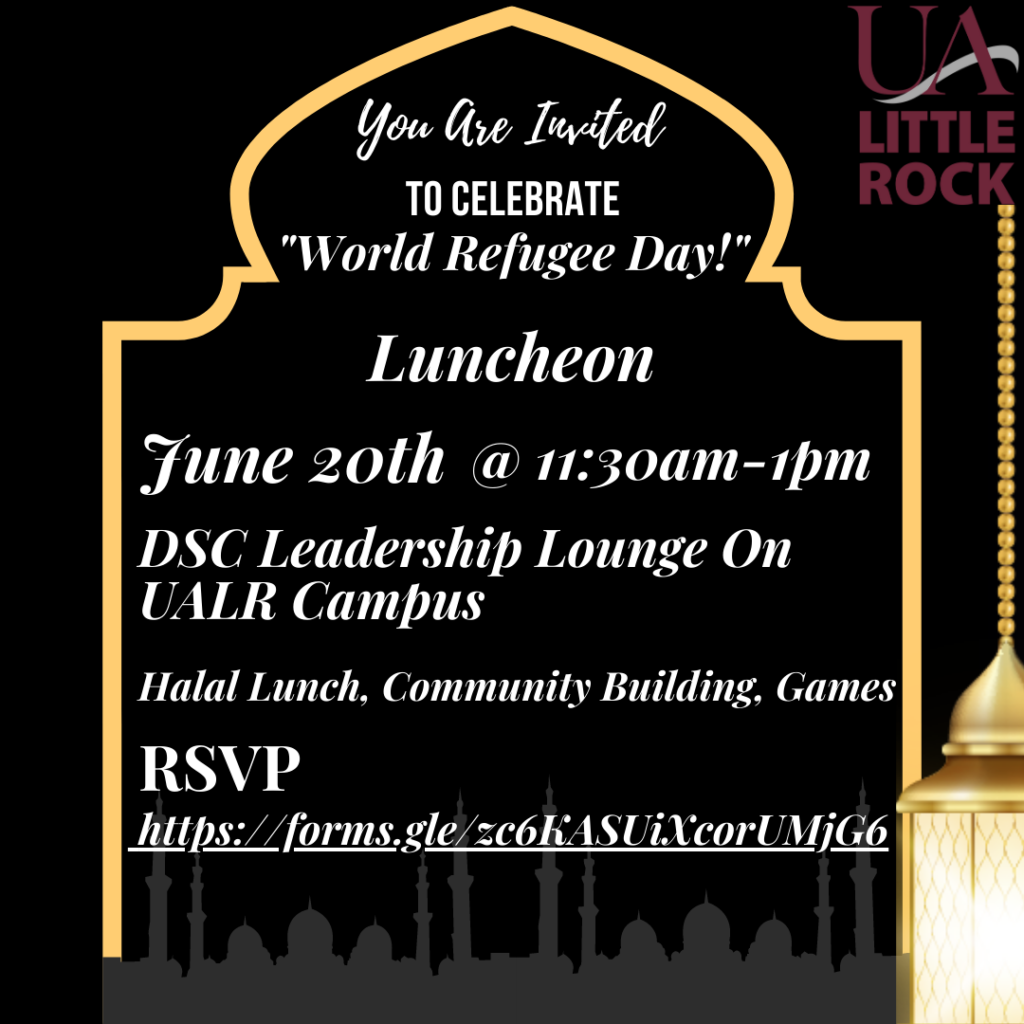
This year, as we read about the struggles of refugees and met with organizations that help refugees in Spain, the students felt inspired to do something more hands-on to connect with refugees in our own community. On June 20, 2023, the students hosted a lunch and community-building event in honor of World Refugee Day. This event, which was attended by about 11 refugee students enrolled in the Intensive English Language Program at the University of Arkansas at Little Rock, as well as the students from the Spain study abroad class and other Muslim students from campus, focused on making connections and building community. We shared a Halal lunch together, got to know each other better, and played games. Yasmeen Smith, one of the students from the Spain study abroad course, said “This event was planned on the premise of extending the hand of friendship, free from prejudices and filled with acceptance.” The event also provided students with the opportunity to apply what they learned; as Yasmeen went on to say, “the understanding and empathy that I’ve gained from this course will be with me for a lifetime.”
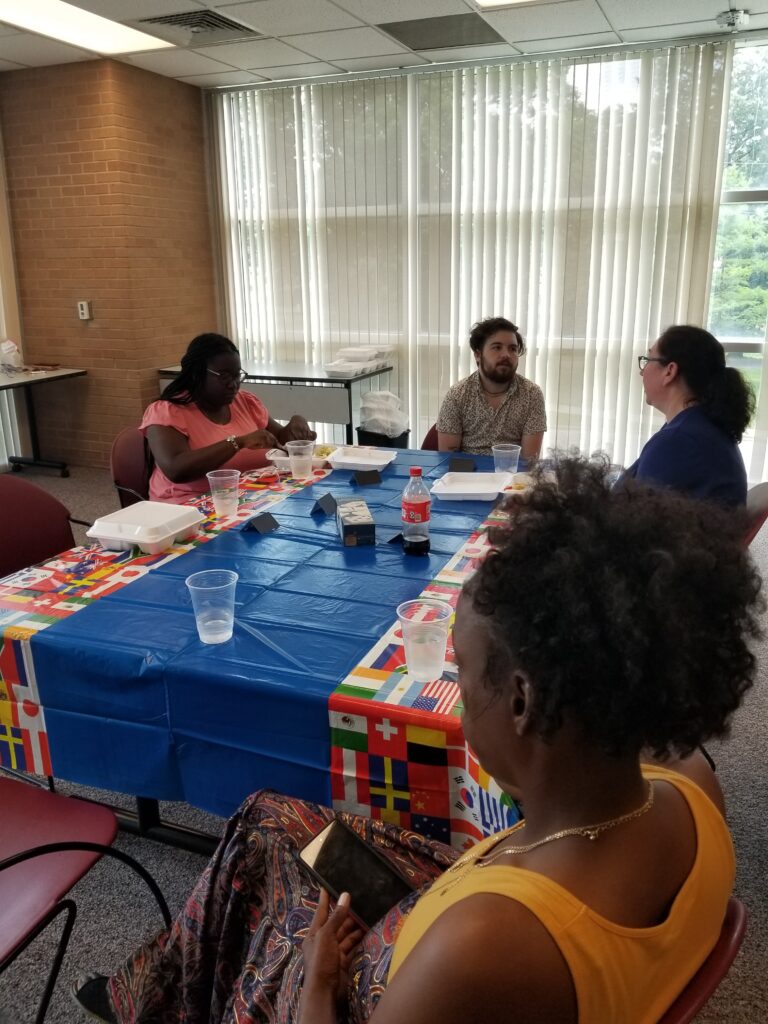
While we laughed over Uno and Exploding Kittens, we saw some of the research findings we studied in our class playing out in practice. Stereotypes and prejudice were dispelled as we connected with each other as real people, shared food, and played together. These experiences help use see one another as more alike than different. As Shalonda Michelle Nelson said after the event, “from a room full of strangers from various lands and backgrounds, we found a space that quickly went from a silent room of uncertainty because of the many differences of religion, race, culture, and language to a room full of laughter, playing family games, and breaking bread together.”
